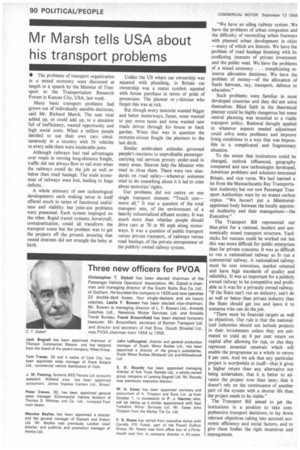Mr Marsh tells USA about his transport problems
Page 92

If you've noticed an error in this article please click here to report it so we can fix it.
• The problems of transport organization in a mixed economy were discussed at length in a speech by the Minister of Transport to the Transportation Research Forum in Kansas City, USA, last week.
Many basic transport problems had grown out of individually sensible decisions, said Mr. Richard Marsh. The sum total added up, or could add up, to a situation full of inefficiency, wasted opportunity and high social costs. When a million people decided to use their own tars simultaneously in a country with 56 vehicles to every mile there were intolerable jams.
Although railways had real advantages over roads in moving long-distance freight, traffic did not always flow to rail even when the railways could do the job as well or better than road haulage. The scale economies of railways were lost, leading to huge deficits.
A whole armoury of new technological developments each making sense in itself offered much in terms of functional usefulness and viability but joint-use problems were presented. Each system impinged on the other. Rapid transit systems, hovercraft, containerization, could all transform the transport scene but the problem was to get the projects off the ground, ensuring that vested interests did not strangle the baby at birth. Unlike the US where car ownership was equated with plumbing, in Britain car ownership was a status symbol, equated with house purchase in terms of pride of possession. The planner or politician who forgot this was at risk.
But though every motorist wanted bigger and better motorways, faster, none wanted to pay more taxes and none wanted new roads driven through his house or back garden. When that was in question the motorist-citizen fought the planners to the last ditch.
Similar ambivalent attitudes governed people's reactions to unprofitable passengercarrying rail services grossly under-used in many areas. Heaven help the Minister who tried to close them. There were two standards on road safety—whenever someone tried to do something about it it led to cries about motorists' rights.
Our problems did not centre on one single transport element. "Touch one— move all." It was a question of the total transport mix, of the environment of a heavily industrialized affluent society. It was much more than whether people should drive cars at 70 or 90 mph along motorways. It was a question of public transport versus private transport, of railways versus road haulage, of the private entrepreneur or the publicly owned railway system. "We have an ailing railway system. We have the problems of urban congestion and the difficulty of reconciling urban freeways with planned urban development in cities —many of which are historic. We have the problem of road haulage licensing with its conflicting interests of private investment and the public weal. We have the problems of a mixed economy . . . complicating resource allocation decisions. We have the problem of money—of the allocation of funds between, say, transport, defence or education."
Such problems were familiar in most developed countries and they did not solve themselves. Blind faith in the theoretical planner could be highly dangerous but some central planning was essential to a viable transport policy. Rational thought applied to whatever aspects needed adjustment could solve some problems and improve living conditions in a way that was impossible in a complicated and fragmentary situation.
To the extent that institutions could be changed, outlook influenced, geography conquered and new technologies developed, American problems and solutions interested Britain, and vice versa. We had learned a lot from the Massachusetts Bay Transportation Authority but our new Passenger Transport Authorities were by no means carbon copies. "We haven't put a Ministerialappointed body between the locally appointed Authority and their management—the Executive."
The Transport Bill represented our blue-print for a rational, modern and economically sound. transport structure. Yardsticks for success could be worked out but this was more difficult for public enterprises than for private concerns. It was as difficult to run a nationalized railway as to run a commercial railway. A nationalized railway must be cost conscious, market oriented and have high standards of quality and reliability. It was as important for a publicly owned railway to be competitive and profitable as it was for a privately owned railway. "If the State can't run an industry, can't do as well or better than private industry then the State should get out and leave it to someone who can do the job.
"There must be financial targets as well as objectives. Our rule is that the nationalized industries should not include projects in their investments unless they are estimated to yield an 8 per cent return on capital after allowing for risk, or else they represent essential renewals which will enable the programme as a whole to return 8 per cent. And we ask that any particular project is worthwhile in itself—that it gives a higher return than any alternative not being undertaken; that it is better to advance the project now than later; that it doesn't rely on the continuance of another part of the system with a shorter life than the project needs to be viable."
The Transport Bill aimed to get the institutions in a position to take comprehensive transport decisions; to lay down relevant objectives taking into account economic efficiency and social factors, and to give these bodies the right incentives and management.




































































































































































































































































